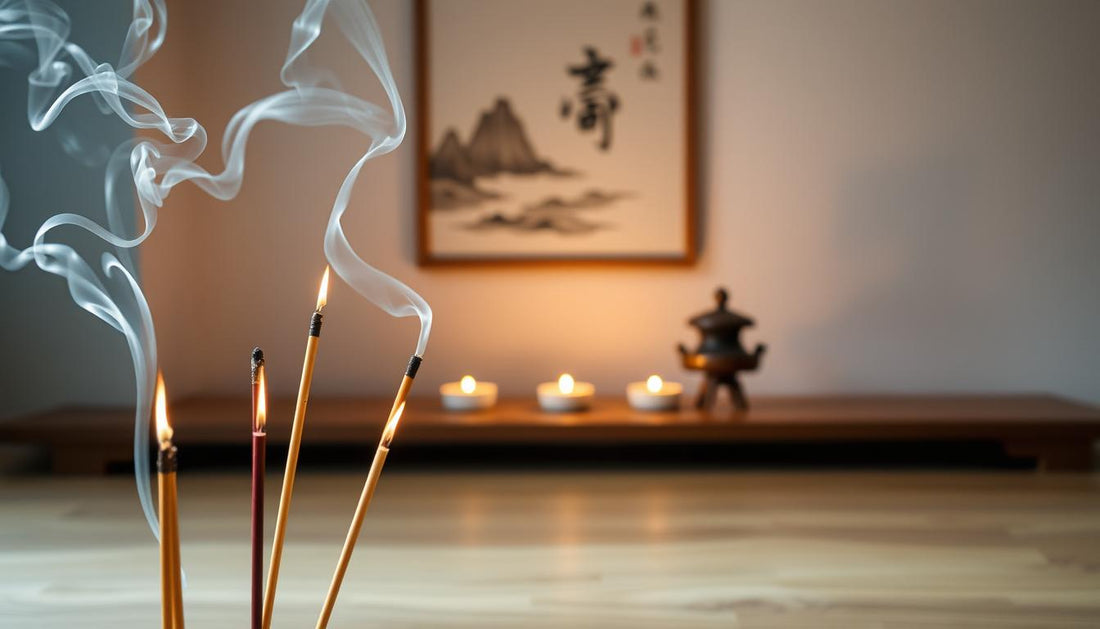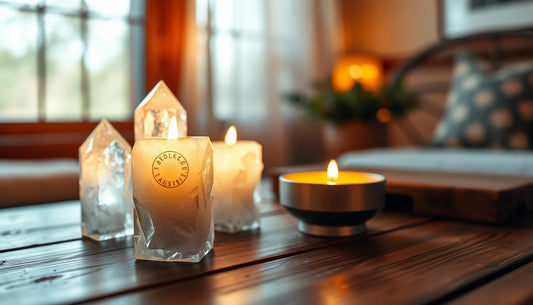
What do incense sticks represent?
"The scent of flowers spreads only in the direction of the wind. But the goodness of a person spreads in all directions." — Chanakya
Incense sticks have a deep meaning in spiritual, religious, and cultural areas. They are not just for nice smells but also for spiritual growth, religious acts, and feeling better.

They are used in meditation to create calm or in ceremonies to connect with the divine. The spiritual value of incense sticks is clear as their smoke goes up, symbolizing prayers and purification. In many cultures, incense sticks help manifest destiny, predict weather, and protect homes. The meaning of incense sticks changes with each religion and tradition. Yet, they are all known for bringing peace in our busy lives. When you light an incense stick, you're not just lighting a stick. You're starting a journey of healing for your body, mind, and spirit.
The Spiritual Significance of Incense Sticks
Incense sticks are more than just a pleasant smell. They have been valued for thousands of years in many cultures and religions. Using incense in your daily life can deepen your spiritual connection and bring peace.

Connecting with the Divine
Incense sticks are used worldwide in religious ceremonies. They are believed to carry prayers to the heavens. About 70% of spiritual groups use incense, especially frankincense and myrrh, for their sacred meanings.
This practice makes rituals more sacred. It also creates a peaceful space for spiritual connection.
Enhancing Meditation Practices
Incense sticks are great for meditation. They help 80% of users relax and focus better. Scents like sandalwood and lotus help reach a deeper state of mindfulness.
Research shows incense can make you feel less stressed and more focused. It's because it creates a calm environment.
Cleansing and Purification
Incense is also used to clean and purify spaces. About 50% of users burn incense like sage to get rid of bad vibes. This practice is like smudging, making spaces ready for spiritual activities.
With 55% preferring natural ingredients, there's a growing interest in organic incense. This shows a desire for genuine and pure spiritual practices.
Using incense can greatly improve your spiritual and personal growth. It turns everyday places into sacred spaces for the soul.
Cultural Meanings of Incense Sticks
Incense sticks play a big role in many spiritual practices around the world. They have different meanings in different cultures, from ancient traditions in the East to modern uses in the West. Knowing these meanings helps us see their value and flexibility.
Eastern Traditions
In Eastern cultures, incense sticks are key in daily spiritual routines, especially in India. They've been used for ages, mainly in Hindu rituals to clean the air and improve spiritual experiences. Each stick can mean something special, like showing respect to a god or helping focus.
Using three sticks might represent the gods Brahma, Vishnu, and Shiva. Five sticks stand for the elements of earth, water, fire, air, and space, seeking balance. Seven sticks are linked to the chakra system, aiming to heal and grow spiritually.

In faiths like Buddhism and Hinduism, burning incense, or Agarbattis, is a big part of worship. It's one of sixteen steps in Hindu worship. Scents like sandalwood, jasmine, and rose have special meanings. Sandalwood and lavender calm, while lemongrass lifts the mood. Ayurveda also values incense for balance.
Western Contexts
In the West, incense sticks are becoming more popular, especially in holistic and spiritual groups. They bring different fragrances and benefits to Western homes and spiritual spaces. People use them for cleaning, meditation, and to set the mood for rituals. Scents like lavender and citrus are favorites for their mood-boosting and calming effects.
Incense sticks are used in many ways, from freshening the air to being part of meditation. Their use across cultures shows their universal appeal and the many ways they're seen. They help create calm and focus, wherever they're used.
The History of Incense Sticks
Incense has a long history, going back to ancient times. It was used by many cultures for spiritual, medicinal, and cultural reasons. Its importance has grown over time, becoming a key part of many traditions.
Ancient Civilizations
In ancient Egypt, incense was used in spiritual ceremonies. Priests thought the smoke carried prayers to the gods. Around the same time, in China, incense was used for religious worship starting around 2000 BCE.
In India, incense sticks were part of Ayurvedic medicine since 600 BC. Scents like Sandalwood, Rose, and Jasmine were used in rituals. The first incense sticks were made in India, a big step in incense history.
In Japan, incense was introduced by Korean Buddhist monks in the 6th century. By the Heian Era, it was loved by the Imperial Court.
Modern Adaptations
Today, making incense is much different. Old methods like hand-rolling are now replaced by new ones like compression and powder-coating. This has led to many types of incense, like coils and cones.
Incense sticks, or joss sticks, are still used in many places for spiritual reasons. In Eastern Orthodox Christianity, incense is made from frankincense or fir resin. In Japan, the art of Kōdō, or appreciating incense, became popular in the 15th and 16th centuries.
Traditional Uses of Incense Sticks
Incense sticks have deep roots in many cultures. They are used in both religious and festive settings. The smoke they produce carries important meanings and benefits.
Religious Ceremonies
In Japan, incense sticks are key in martial arts dojos. They symbolize courage and strength. In Bhutan, lighting incense in temples shows respect to deities.
It connects humans to the divine. In Chinese spirituality, incense sticks are lit in temples. They are used to worship, showing devotion.
In ancient Egypt, incense sticks were used in medicine. They helped with pain and healing. Blends like myrrh and frankincense were used.
Festive Occasions
Incense is essential in festive celebrations. In Hindu ceremonies, incense is part of the worship process. It symbolizes offerings to society and the divine.
In Bhutan, incense is used for worship, healing, and meditation. It connects the body, mind, and spirit. Satya incense is popular in Indian homes and temples.
It adds fragrance to celebrations. Incense fragrances are also used as air fresheners. They bring positivity and clean environments.
| Country | Usage | Significance |
|---|---|---|
| Japan | Martial Arts Dojos | Symbolizes courage and resilience |
| Bhutan | Temples and Monasteries | Connection between human realm and divine |
| China | Temples | Worship and divine connection with sandalwood and agarwood |
| India | Households and Temples | Enhances rituals and celebrations |
Incense Sticks Meaning
Incense sticks hold deep meanings across cultures and spiritual practices. They reflect traditions, beliefs, and rituals from centuries ago. Their origins show a rich history and spiritual importance.
The use of incense dates back to ancient times, like Babylon. There, people used incense to read smoke patterns, called libanomancy. Certain patterns were believed to mean different things, like victory or financial success. This shows the mystical side of incense.
Incense sticks are used for spiritual purification, meditation, and ceremonies. They create a calm atmosphere and help focus. This is why 90% of yoga and meditation sessions use incense.
In ancient Egypt, frankincense was used for religious offerings. Today, it's known for calming effects. About 70% of people find it helps during stressful times.
Scents like lavender and chamomile can calm the mind. They might even reduce nightmares and improve sleep. Some scents can also lower stress and anxiety by up to 30%.
Burning incense is thought to make prayers 50% more effective. It creates a focused space for spiritual practices. About 60% of people find it positively impacts their spiritual well-being.
In summary, incense sticks mean more than just their smell. They are used for meditation, purifying spaces, and enhancing spiritual practices. They carry a rich heritage and are important in understanding incense symbolism today and in history.
Benefits of Burning Incense Sticks
Burning incense sticks can greatly improve your well-being and daily life. They offer spiritual upliftment and practical uses. This section will explore how incense aids in aromatherapy, stress relief, and relaxation.
Aromatherapy Benefits
Incense sticks have many benefits, especially in aromatherapy. They release fragrant smoke that turns any space into a peaceful place. Lavender, for example, helps you sleep better.
Other calming scents like Vetiver and Chamomile also improve sleep. Sandalwood and Lotus enhance focus during meditation. Jasmine, Vanilla, and Rose boost sexual desire. Cinnamon is known for its passionate scent.
Stress Relief and Relaxation
Incense sticks are great for reducing stress and promoting relaxation. Burning them can calm your heart rate and breathing. This is perfect for finding peace after a long day or during meditation.
Scents like Frankincense and Myrrh not only relax but also reduce inflammation. This can help with muscle and joint pain. Studies have shown these benefits.
A study by the University of Freiburg found that rose-scented incense improves vocabulary. Lavender incense was also shown to reduce menstrual cramps in a 2012 study.
Incenses like Eucalyptus and Tea Tree can also boost your immune system. Choosing the right incense is key to getting the most benefits.
| Fragrance | Primary Benefits |
|---|---|
| Lavender | Improves sleep quality, reduces menstrual cramps |
| Sandalwood | Enhances focus, spiritual connection |
| Jasmine | Increases sexual desire |
| Frankincense | Anti-inflammatory, relaxation |
| Eucalyptus | Boosts immunity |
Incense sticks offer many benefits for mental and physical health. They are great for aromatherapy, stress relief, and improving focus. The benefits of incense are wide and transformative.
Significance of Different Incense Stick Scents
Incense stick scents have a big impact on our spaces. They bring different energies and purposes, improving our spiritual and emotional health. From floral to woodsy, each scent has its own benefits to uplift our minds, bodies, and spirits.
Floral Scents
Floral incense offers many benefits, like promoting love and emotional healing. Jasmine incense boosts creativity and attracts love and money. Lavender incense helps with stress and brings happiness.
Rose incense is great for love and fertility, adding romance to your space. Other floral scents like ylang-ylang and frangipani also help with emotional well-being. Ylang-ylang fights depression and fosters love, while frangipani brings peace and balance.
Woodsy Scents
Woodsy incense brings calm and grounding to your space, perfect for meditation. Cedar incense purifies and attracts love. Its scent clears negative energies, creating a peaceful environment.
Sandalwood incense is known for spiritual growth and love. Patchouli stimulates spirituality, great for meditation. These scents connect us to our spiritual side, grounding our energies.
Knowing the benefits of different incense scents helps choose the right one for your needs. Whether it's for love, peace, or spiritual growth, using these scents can make your space more positive and uplifting.
Significance of Different Incense Stick Scents
What do incense sticks represent?
Incense sticks have been used for centuries across various cultures and religions. They often represent a connection to the spiritual world. They offer a medium for prayers, meditations, and rituals to reach the divine.
How do incense sticks help in connecting with the divine?
Incense sticks are commonly burned during prayers and rituals. The rising smoke is believed to carry one's intentions, prayers, and wishes to the spiritual realm. This fosters a deeper connection with the divine.
How can incense sticks enhance meditation practices?
The calming aroma of incense sticks helps create a serene environment. This makes it easier to focus and be mindful. It helps tap into deeper states of meditation and inner peace.
Can incense sticks be used for cleansing and purification?
Yes, many believe that burning incense sticks can purify a space. They dispel negative energies and invite positive vibes. This makes them a popular choice for cleansing rituals.
What is the significance of incense sticks in Eastern traditions?
In Eastern cultures, especially in countries like India, Japan, and China, incense sticks are used in religious ceremonies and meditation. They are believed to purify the surroundings and aid in spiritual well-being.
How are incense sticks perceived in Western contexts?
In the West, incense sticks are often used for aromatherapy and creating a pleasant atmosphere at home. They are also gaining popularity in spiritual circles for their calming and purifying properties.
What role did incense sticks play in ancient civilizations?
Incense sticks were integral to ancient civilizations such as Egypt, China, and India. They were used in various rituals, temple offerings, and even in medicine to treat ailments.
How have incense sticks evolved in modern times?
Today, incense sticks are widely available and come in myriad scents and forms. While their traditional uses remain, they are now also popular for everyday home fragrance, relaxation, and as an aid in mindfulness practices.
How are incense sticks used in religious ceremonies?
Incense sticks are often used in religious ceremonies to honor deities and purify the ceremony space. The aroma is believed to help elevate the spiritual atmosphere.
Are incense sticks used in festive occasions?
Yes, incense sticks are commonly used during festive occasions. They invoke blessings, create a festive ambiance, and invite positive energy into homes and community spaces.
What meanings are often associated with incense sticks?
Incense sticks symbolize spirituality, purity, and the ethereal connection between the physical and spiritual worlds. Different cultures and traditions imbue them with varied meanings, often connected to ritualistic and ceremonial uses.
What are the aromatherapy benefits of burning incense sticks?
Burning incense sticks has notable aromatherapy benefits. They reduce anxiety, improve mood, and promote relaxation. Different scents cater to different emotional and mental needs.
How do incense sticks aid in stress relief and relaxation?
Certain incense stick scents, such as lavender and sandalwood, are known for their calming effects. Burning these can help reduce stress levels, promote relaxation, and enhance sleep quality.
What is the significance of floral incense stick scents?
Floral scents like jasmine and rose are often associated with love, harmony, and peace. They are used in rituals to invite these qualities into a space and support emotional well-being.
What do woodsy incense stick scents represent?
Woodsy scents such as sandalwood and cedar are typically used for grounding, protection, and purifying spaces. They help create a more stable and secure environment, perfect for meditation and spiritual practices.

